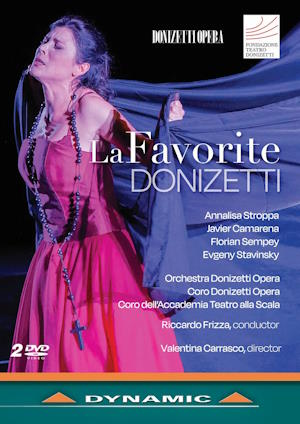
Gaetano Donizetti (1797-1848)
La favorite, opera in four acts (1840)
Sung in French to a libretto by Alphonse Royer and Gustave Vaëz
Léonor de Guzman: Annalisa Stroppa
Fernand: Javier Camarena
Alphonse XI: Florian Sempey
Balthazar: Evgeny Stavinsky
Don Gaspar: Edoardo Milletti
Inès: Caterina Di Tonno
Un seigneur: Alessandro Barbaglia
Coro Donizetti Opera, Coro dell’Accademia Teatro alla Scala
Orchestra Donizetti Opera/Riccardo Frizza
Valentina Carrasco (stage direction)
rec. 2022, Teatro Donizetti, Bergamo, Italy
Dynamic 37992 DVD [2 discs: 190]
Donizetti composed his four-act grand opera La favorite in French for the Paris Opéra, although it might now be more often done in an Italian translation as La favorita. Some Donizetti authorities insist on the French original, including William Ashbrook (Donizetti and his Operas, page 447). He writes that it is one of the composer’s best works, and that it is “not just another Italian Romantic melodrama but an elegant French opera, which needs the focus and incisiveness of Donizetti’s original setting of its French text to allow its controlled passion to show through its polished surface.” Here we have the full text – Parisian grand opera obligatory Act Two ballet and all – in Rebecca Harris-Warrick’s new critical edition. This includes the cabaletta of the Léonor-Alphonse duet, cut after the first night because of political sensitivities. The excellent booklet notes say the new edition puts this in an appendix, but it is sung in this production possibly for the first time since that 1840 premiere.
The opera is set against a background of the 14th-century Moorish invasions of Spain, and the conflict between church and the state. The novice monk Fernand abandons his monastery. He fell in love with the noble Léonor, unaware that she is the King’s mistress and favourite. As so often, pieces of paper have a role in the plot: a military commission, two mislaid lovers’ notes and a papal bull – but these devices matter less. What is important is that the opera, which has no real villain, focusses on plausible conflicts of character and motivation as it progresses to its conclusion. Valentina Carrasco’s production keeps that at the forefront of the action, in a very satisfying manner.
The setting does everything the libretto requires, without drawing attention to itself. The scenery is suggestive more than realistic, with much gauze and a set of bars that close and open across the whole stage. Costumes are vaguely ‘period’ if hardly 14th century, with an imperial purple gown for Léonor, the royal mistress. For the ballet, the director imagines a court of now neglected former mistresses getting dressed “for a party to which no-one has actually invited them, least of all the King”. The performers are neither dancers (as there is no dancing) nor professional actors, but “ordinary” women from Bergamo. They act out these roles while the ballet music, not the strongest part of the score, is played.
The casting is very good indeed. Italian mezzo-soprano Annalisa Stroppa as Léonor de Guzman is a superb lead, dignified or passionate toward the three male characters who make demands upon her. She sings with a rich middle and lower register and, when needed, a piercing upper range. Her O mon Fernand scene in Act Three is a touching moment, well sung – at moments it goes high for a mezzo – and well-acted, even as she removes her top and closes the solo in just a purple bra. Mexican Javier Camarena’s fine tenor, with smooth production and a ringing top, serves well the honourable character of her lover Fernand. He sings beautifully the score’s best-known number, the Act Four Ange si pur (Spirto gentil in the Italian version). The Act One duet of these two is an early highlight.
As Alphonse XI, Florian Sempey, the one lead who is French, brings regal authority with his stage presence and rich baritone. Evgeny Stavinsky’s Balthazar is surprisingly sympathetic despite being everyone’s moral arbiter. His Russian bass is typically weighty but smoother and steadier than some of his compatriots’.
The Orchestra Donizetti Opera and the combined choirs are all fine. Riccardo Frizza must now know more about conducting Donizetti than almost anyone. The French grand opera style expects a bigger contribution from the orchestra than most Italian operas of the era, and these players sound entirely idiomatic.
I have heard neither of the other accounts of La favorite available on video, in 2018 at Maggio Musicale Florence (review), and in 2014 at Toulouse (review). Regardless, I was impressed by the Bergamo performance and its presentation on stage and on disc.
Roy Westbrook
Help us financially by purchasing from



Production staff
Chorus master: Salvo Sgrò
Choreographer: Massimiliano Volpini
Set designers: Carles Berga and Peter van Praet
Lighting designer: Peter van Praet
Costume designer: Silvia Aymonino
Video direction and editing: Matteo Ricchetti
Video details
Format and aspect ratio: NTSC 16:9
Audio: PCM 2.0, Dolby digital 5.1
Region code: 0, all regions
Subtitles: Italian, English, French, German, Japanese, Korean
Booklet notes: Italian, English

















